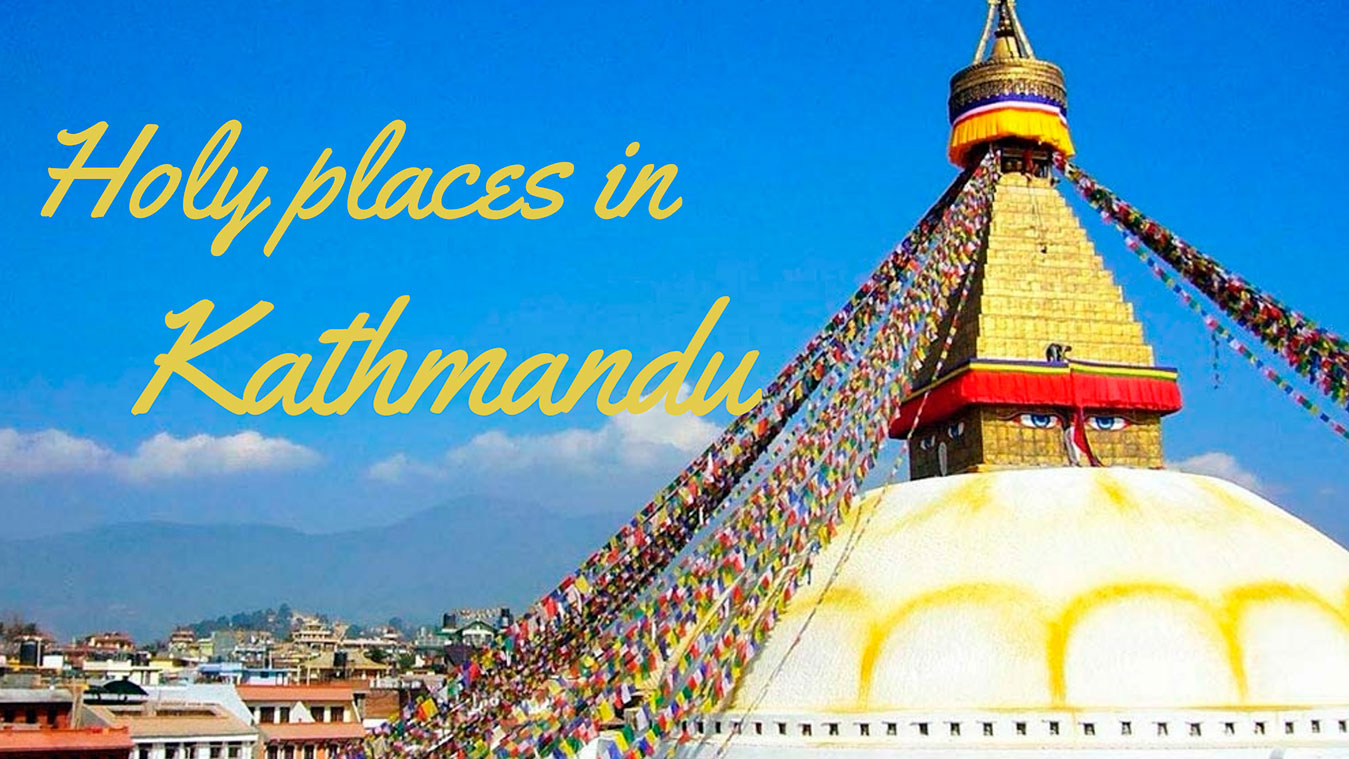
Nepal is the sovereign Himalayan nation of the brave Gorkhalis that has never been conquered by any foreign power. The capital city of the nation is Kathmandu. The city is located inside Kathmandu Valley which comprises of other two cities i.e. Lalitpur and Bhaktapur.
The valley has witnessed various ruling dynasties and their diverse concepts in religions; therefore inheriting different religions, their deities, and the numerous sites devoted to them. The valley observed numerous rulers belonging to different dynasties with the utmost adoration to the Hindu and Buddhist religions; therefore, these rulers built numerous state-of-art (of their time) structures dedicated to their divinity and curved sublime fine arts on each corner of these religious structures to impress their deities and of course, to record their name in the history forever.
Consequently, the valley became renowned for its temples, monasteries, stupas until now via the glorious history that these structures have been conserving for centuries.
Kathmandu Valley has a step forward to the contemporary, modern world; whereas, it still has a foot backward in the history via delicate balance it maintains between the influence of two ancient, yet major religions and the valley flaunts this achievement down the religious structures based inside its periphery.
Residents of the valley have strong faith in their religions and intensely believe in their deities, worshipping them in their place of worship regularly or in the different occasions/festivals devoted to them. Here, is a quick look at these places of worship bearing the religious values, and the faith of the residents of the valley as well as of the world found inside the ancient Kathmandu Valley:
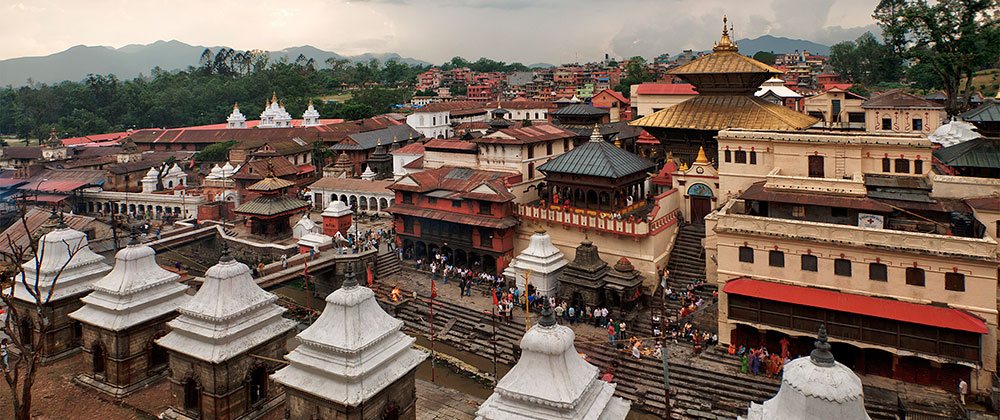
The most sacred Hindu shrine located on the banks of the holy Bagmati River, Pashupatinath Temple is dedicated to Lord Shiva: The mightiest deity in Hindu religion and the destroyer represented as the Shiva Linga; alongside, the statues, shrines, and temples dedicated to other deities in the complex.
The foremost temple featuring pagoda construction i.e. devoted to Lord Shiva inside the complex is adorned with a gold-plated roof, silver doors, and woodcarvings of the finest quality.
Another prominent temple inside the Pashupatinath complex is Guheswari Temple devoted to Satidevi: The consort and source of the power of Lord Shiva, who gave up her life in the flames of her father's fire ritual in the response to the insults made by her father against Lord Shiva.
There is Arya Ghat (cremation grounds) on the banks of the holy Bagmati River. Enlisted as one of the UNESCO World Heritage Site, Pashupatinath Temple witnesses thousands of worshippers and devotees pay their tribute each year; notably during the providential festival of Mahashiva Ratri.
The sacred temple is a major attraction for tourist sightseeing inside the Kathmandu Valley and the visitors love the spiritual atmosphere perceived inside the holy complex.
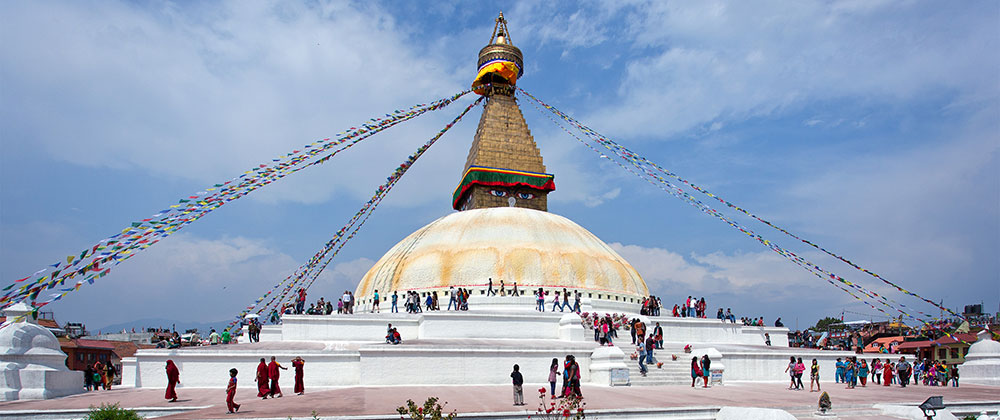
Enlisted as one of the UNESCO World Heritage Site; Boudhanath is one of the largest stupas in the world. Considered as the core of Tibetan Buddhism in Nepal; the stupa commands the skyline with the white mound emerging thirty-six meters above the sky.
The Stupa is believed to entomb the remains of Kasyapa Buddha and is the most sacred Buddhist shrine. Situated on the ancient trade route to Tibet; Tibetan merchants took a break and paid their homage to the Boudhanath Stupa for many centuries.
The Boudhanath complex is vivid, providing a sense of spirituality and peace to the soul of the one visiting it. Also, one can observe radiant colors on every corner in the form of wavering prayer flags in mid-air around stupa along with hand-woven carpets, varicolored Thangkas and masks, Khukuri knives, and Tibetan jewelry that are sold in the surrounding stalls.
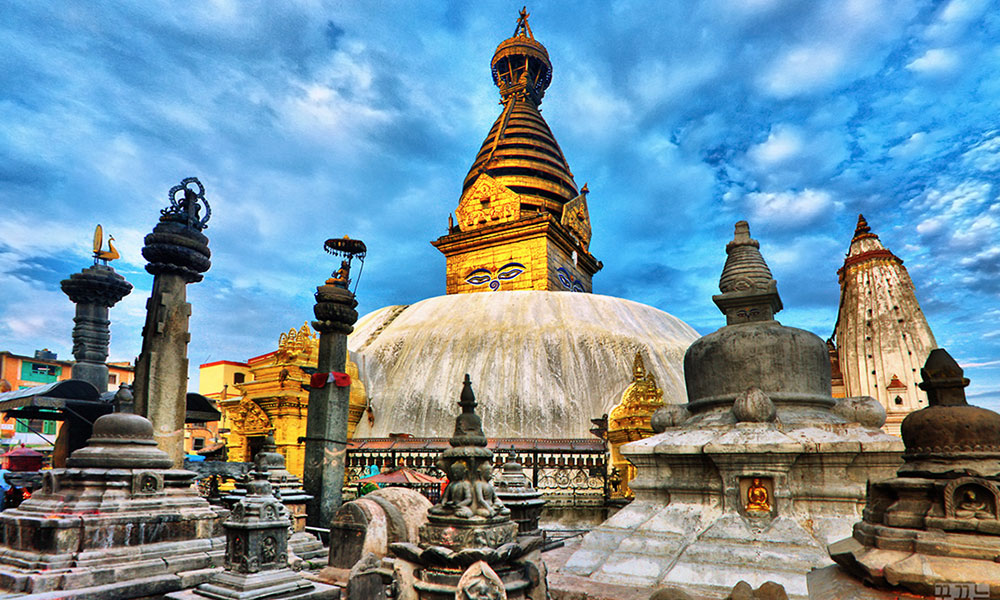
Swayambhunath is probably the most sacred shrine among Buddhist devotees and second to the Boudhanath. The stupa is amid the most ancient structure in these regions of the world, with the list of diverse worshippers including Tibetan monks, Newar nuns, and Brahmin priests that portrays an exemplary religious harmony found in the Himalayan nation.
Also nicknamed as Monkey Temple, the golden tower above the white stupa has the celebrated Buddha’s eyes painted on it observing wisely from all four directions signifying the all-seeing prehistoric Buddha; along with the eyebrows above the eyes and number one (in Devanagari script) painted in the style of a nose between the eyes.
Beside the stupa, the largest image of the Sakyamuni Buddha in Nepal is situated. Swayambhunath Stupa is a paramount landmark of the Kathmandu Valley and is regarded as a beacon below the Nagarjun hill providing an alluring overview sight of the Kathmandu Valley.
The site has two access points: the eastern side comprising of 365 ancient steps from where devotees have to climb up to the Swayambhunath complex; whereas, the western road renders you to get off your transport almost at the base of the stupa.
Mini stupas and monasteries, Statues of the Buddha, monasteries, and mischievous monkeys tend to make the fairly abrupt ascend from the eastern entrance to the Swayambhunath complex- noteworthy.
The enormous gold-plated Vajra ‘thunderbolt’ on the east side of the stupa and Buddha statue on the west side of the Swayambhunath is the must-visit place once you have reached there.
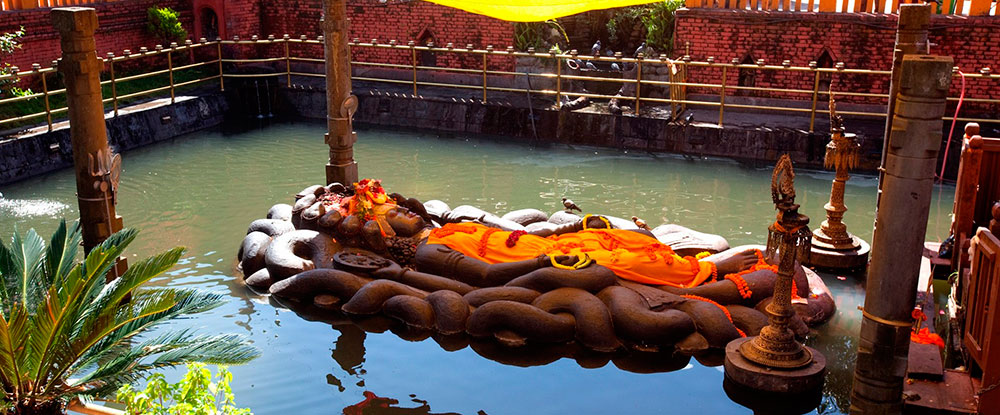
Established at the base of the Shivapuri Hills, the sacred temple of Budhanilkantha is well-renowned for its astounding 5m long statue of Lord Bishnu reposing on a stone bed of coiled snakes aka “Sesha Naga” in the middle of adjourned pond i.e. 13m long in length.
It is believed that the statue was sculpted from a single block of stone around the 7th century. Legends surround the temple. As one of the legends goes way back to the Malla Dynasty; where the ruling king Pratap Malla had a prophetic vision that led to believe that all the monarchs of Nepal will die if they ever visited the temple of Budhanilkantha.
Haribondhini Ekadashi Mela is the temple's prime festival that is celebrated on every 11th day of Kartika (October–November); marking the awakening of Lord Bishnu from his long sleep.
The festival is attended by numerous devotees inside the temple premises. The stone statue of Budhanikantha is said to keep floating on the water in the pond. It is an enchanting fact but any concrete evidence is unavailable to date.
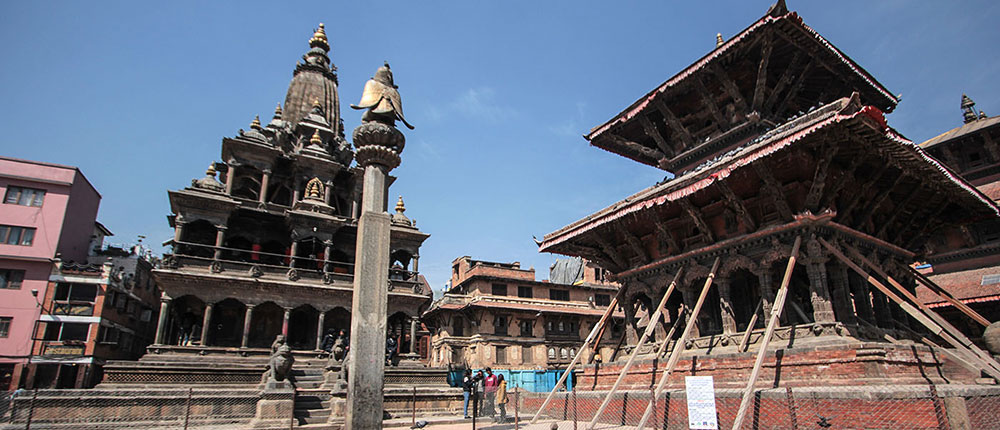
The temple, devoted to Lord Krishna: the 8th avatar of Lord Bishnu, is located in the Patan Durbar Square complex. The temple was forged by curving the stone instead of using regular timber and wood and clearly reflects the Indian temple design.
Nevertheless, it is one of the most exemplary demonstrations of Nepali craftsmanship. Constructed in the 16th century by King Siddhi Narasingh Malla, the temple features three stories. The temple highlights the incidents from the Mahabharata and Ramayana epics curved in low relief.
The highest degree of impressive stone carving skills of ancient Nepalese sculptors can be noticed here. Krishnasthami aka Krishna Jayanta, a major festival is held inside the temple premises, in the Nepali month of Bhadra (August to September); celebrating the birthday of Lord Krishna.
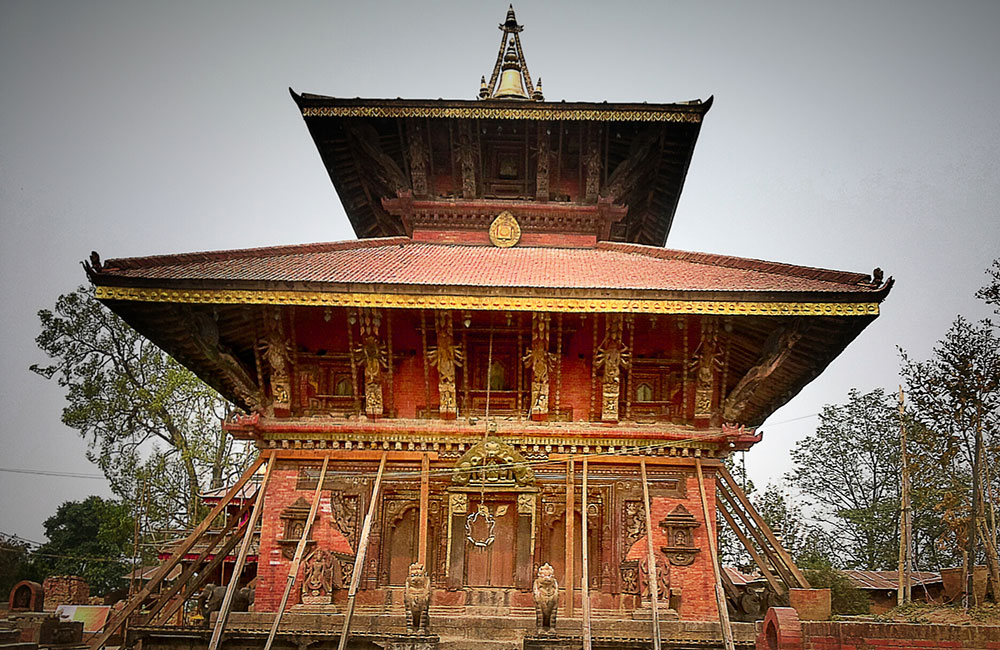
Located in the Changunarayan Municipality of Bhaktapur District of Nepal; the ancient Hindu temple of Changunarayan is encircled by the village of Changu and Champak woodland. Changunarayan can be observed from miles away as fact that it is situated on a hilltop known as Changu or Dolagiri.
The Hindu temple is devoted to Lord Bishnu: the preserver in Hindu mythology and its origin trails back to the 4th century. Found in the temple, a 5th century stone inscription manifests the Changunarayan to be the oldest shrine found anywhere around Kathmandu Valley.
The temple is made up of wood, metal, and stone; flaunting the exemplary Newari art and architecture of the early century. Ten incarnations of Lord Bishnu curved on the bar of the framework of two-stories Changunarayan Temple along with a stone statue demonstrating the cosmic form of Lord Bishnu that dated back to the 6th century.
The stone statue particularly narrates the Garuda avatar of Lord Bishnu: a mythical bird i.e. half man and half bird. Nonetheless, there are some must-see sculptures of Lord Bishnu in the temple such as Vishnu Vikranta, Narsimha Vishnu, Vishwaroop, and much more.
Leave Your Comment